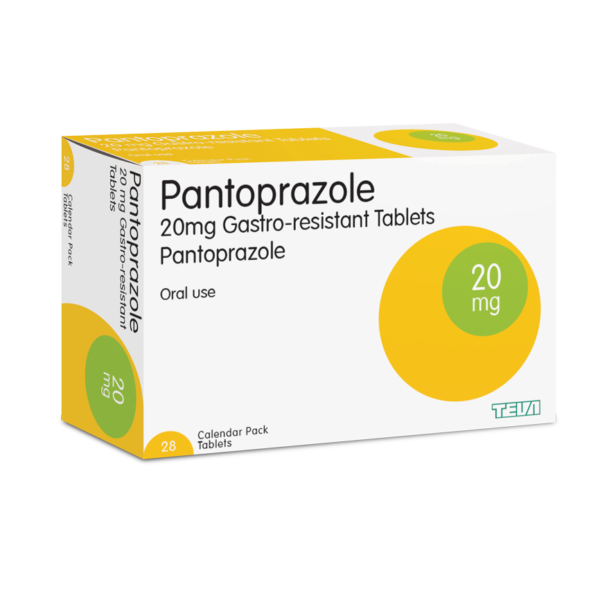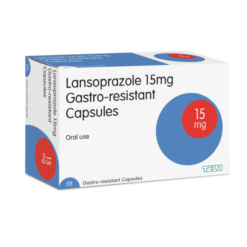-
NHS
-
Oldham Services
-
Shop
-
Help & Advice
-

From £16.99
Variety of delivery options including next day & free delivery.
Pharmacy, clinic and prescribers based in Greater Manchester.
Start your treatment with a quick and free online consultation.
 This is a prescription product.
This is a prescription product.You need to complete a consultation form and allow our pharmacists to access your NHS records for review before we can issue this treatment.
Variety of delivery options including next day & free delivery.
Pharmacy, clinic and prescribers based in Greater Manchester.
Start your treatment with a quick and free online consultation.
Fill in a quick online consultation for our licensed pharmacists to review.
Our pharmacists will review your treatment to ensure it’s suitable.
Your treatment will be delivered to your door quickly & discretely.
Pantoprazole 20mg is a medication known as a Proton Pump Inhibitor, or PPI for short. It’s designed to reduce the amount of acid your stomach makes, which helps effectively manage and treat acid-related stomach and oesophagus issues. In the UK, Pantoprazole 20mg and 40mg can be obtained with a prescription from your GP or pharmacist.
| Feature | Pantoprazole |
|---|---|
| Classification | Proton Pump Inhibitors (PPI) |
| Uses | Treats acid reflux, GORD, stomach ulcers, Zollinger-Ellison syndrome |
| Suitable for | Adults and children over 12 |
| How it works | Pantoprazole prevents proton pumps in the stomach from functioning properly. These proton pumps are enzymes found in the lining of the stomach which contribute to the production of acid, thereby resulting in digestion. |
| Side effects | Benign polyps in the stomach, headache, dizziness, diarrhoea |
| Active ingredient | Pantoprazole |
| Availability | Over-the-counter (20mg) and by prescription (40mg) |
Pantoprazole is used to treat several conditions that are caused by too much acid being produced in the stomach. It’s effective for easing symptoms and prescribed for conditions like:
Pantoprazole is suitable for adults and children over the age of 12 years. It’s important for patients to consult with their GP or pharmacist before starting pantoprazole, especially if they:
It’s also not suitable for people who are taking certain medications that could interact with Pantoprazole, so it’s always best to check with a healthcare professional.
Pantoprazole is part of a group of medicines called proton pump inhibitors (PPIs), which work by reducing the amount of acid your stomach makes. Pantoprazole does this by blocking the action of the proton pumps in your stomach lining, where these pumps are the final step for acid production in the stomach. By blocking them, Pantoprazole reduces the acidity in the stomach and helps to relieve the symptoms of heartburn and other acid-related problems.
You should take Pantoprazole gastro resistant tablets as follows:
Like all medicines, Pantoprazole gastro resistant tablets can cause side effects, although not everyone gets them:
If you experience any allergic reactions or skin conditions, stop taking Pantoprazole immediately and contact 999. Inform your GP or pharmacist of these reactions.
You can find a full list of side effects in the Pantoprazole Patient Information Leaflet.
Pantoprazole is generally only prescribed for short-term use. However, sometimes your doctor or healthcare adviser may recommend that you take it for a longer period of time, in some cases, this can be months or years. Despite the widespread use and excellent safety profile of Pantoprazole 20mg, there are concerns about the long-term effects of proton pump inhibitors. These concerns include potential adverse effects like hypergastrinemia, the development of pneumonia, and drug interactions. The NHS advises that it should be used under medical guidance for the most effective and safest long-term treatment.
Recent studies have also suggested that long-term use of PPIs, like Pantoprazole, may be linked to an increased risk of dementia.
If you are unsure about the need for long-term use of Pantoprazole and are concerned about side effects, you should speak with your GP or pharmacist.
Active ingredient: Pantoprazole (as sodium sesquihydrate)
Inactive ingredients: Sodium carbonate (anhydrous), Mannitol, Crospovidone, Povidone K90, Calcium stearate, Hypromellose, Povidone K25, Titanium dioxide (E171), Yellow iron oxide (E172), Propylene glycol, Methacrylic acid-ethyl acrylate copolymer (1:1), Polysorbate 80, Sodium lauryl sulfate, Triethyl citrate, Shellac, Red iron oxide (E172), Black iron oxide (E172), Ammonia solution.
If Pantoprazole isn’t right for you, there are other Proton Pump Inhibitors you can try for acid reflux, heartburn, and indigestion. Click2Pharmacy offers alternatives like Lansoprazole, Esomeprazole, and Omeprazole. You can buy them online following a consultation with one of our pharmacists.
Pantoprazole is a reliable choice for managing conditions such as acid reflux and indigestion. You can purchase Pantoprazole through Click2Pharmacy by completing our online consultation form, where our licensed pharmacists will review your information. At Click2Pharmacy, our UK-regulated pharmacy features a specialised acid reflux clinic designed to assist you in selecting the appropriate treatment with complete privacy and competitive online prices. Fill out our online assessment now to buy Pantoprazole online today.
EXCELLENT
It’s best to take your Pantoprazole tablet about an hour before you eat. This timing helps the medication work effectively when your stomach starts to produce acid for digestion. Most people take their dose in the morning, but if you’re advised to take it twice a day, the second dose should be taken before the evening meal.
Pantoprazole acts by blocking a specific system in the stomach cells called proton pumps, which are responsible for secreting stomach acid. By inhibiting these pumps, Pantoprazole reduces the overall acid levels in the stomach, providing relief from acid reflux symptoms and helping to heal ulcers.
Pantoprazole, at a lower dose of 20mg, is available without a prescription for managing short-term reflux symptoms like heartburn. If you require a higher dose or need to use it for a longer period, book a consultation with Click2Pharmacy, where our pharmacists can determine if a prescription is right for you.
The relief from symptoms can be felt as quickly as within a few days of starting Pantoprazole. However, for the medication to have its full effect, especially for conditions like GORD, it may take up to four weeks. If you don’t feel better after this time, it’s important to consult your GP or pharmacist.
The duration of treatment with Pantoprazole can vary. For short-term problems, such as mild heartburn or reflux, you might only need to take it for a couple of weeks. For chronic conditions, your GP or pharmacist might recommend a longer treatment period. Always follow the guidance of your prescriber regarding the duration of use.
Pantoprazole is a great option for those suffering from acid reflux or related issues such as heartburn and stomach ulcers. These conditions are often really uncomfortable, and we generally find that most patients get great relief from taking medications such as Pantoprazole. What’s more, this is a low risk medication and serious side effects are incredibly uncommon.
We generally only prescribe Pantoprazole for short term use, so if you do suffer with long term acid reflux it’s really important that you book in with your GP to investigate this further so you can find the root cause of the issue. Overall, we see really positive outcomes from the use of this drug, both in the 20mg and 40mg doses.

Sakib Mohammed
MPHARM
Page content authored by Sakib Mohammed, last reviewed by Dr Hussain Ahmad on 27th October 2024.





